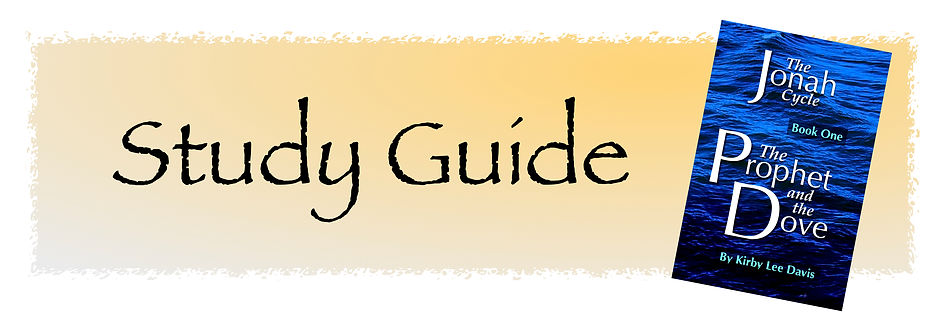

Get ready for a behind-the-scenes trip through my novel The Prophet and the Dove. Written for individual or small-group usage, this guide:
• Breaks down each chapter by its biblical and historical roots. In this, the guide works in tandem with the novel’s glossary, which provides general backgrounds for the names, places, and other specific elements raised in its narrative.
• Evaluates key plot elements while posing discussion questions, all to help readers consider these points from a contemporary, personal perspective.
In this way the novel and guide may combine to serve as a Bible study, a Sunday school lesson series, or a package of devotionals.
I wrote The Prophet and the Dove to honor Jonah’s ministry, filling out that brief Old Testament book for modern audiences seeking more realism and detail than ancient authors typically provided. Even with that book’s amazing miracles, its most important elements reflect deeply human trials over faith, hope, and love. My goal was to help readers better understand these elements, all while delivering a greater appreciation for his epic adventure. Too many people dismiss Jonah’s exploits as a myth or children’s fable. His tale deserves far more respect.
This leads to our opening question: Why did the Book of Jonah’s original author(s) omit so many details? For a variety of reasons, including:
• Long-held traditions of leaving out story elements considered unimportant to the author’s primary message.
• Common practices of skipping over cultural habits or nuances their audiences would consider routine or take for granted.
• Practical limitations of materials and costs. Concise text and strong editing proved a necessity when recorded histories or tales had to be carved into stone, scratched into clay tablets (which must then dry for long-term use), sewn into garb, or scribbled as stains upon dried animal skins.
For all these reasons and more, most tales and histories were shared orally in ancient times - which reinforced tight editing practices. The development of paper, low-cost inks, and the printing press made keeping and sharing longer documents easier, but they remained expensive. Only the declining costs of computer memory over the last two decades removed the economic limitations of a document's length, and then only in its electronic form. But even with that advancement, publishers stressed strong editing and quality prose to retain fickle readers.
This study guide will note additional reasons as users delve deeper into the novel.
I make no claims The Prophet and the Dove accurately fills in these missing pieces, but I hope the novel comes close. I mixed a fair amount of research with prayer and common sense to complete it.
Our actual knowledge of this period remains limited. Time, warfare, and natural disasters destroyed many of the archives and artifacts from those years. My novel’s cultural and economic foundations adapt what we know or perceive of that era. Some of its plot elements – such as the appearance of key biblical personalities – may bend some accepted timelines, which are themselves educated guesses. And some of my choices, while based on historical precedent, also reflect efforts to entertain readers.
That brings us to our discussion questions. They range from common sense and personal inquiries to thoughtful interpretations and theology. The study guide supplies few direct answers, for with the novel, the Bible, and its plentiful analyses to draw upon, I saw no need to impose myself in this way. If you’re lucky enough to experience dissension with these questions, the debaters should identify and cite Bible verses or other authoritative sources that support their positions. Today's augmented Bibles offer a good starting point; one focused on archeology might provide more issues to argue. This point-counterpoint process may continue until one side gives in or everyone agrees to disagree.
Since this guide deals in historic and biblical generalities, it may disappoint those seeking detailed citations and source information. I apologize for that. As noted in the afterward, this book was researched and written more than three decades ago, and many of my notes and records were lost in multiple moves over the years. The afterward provides some reference works I still appreciate. The web naturally offers some good starting points, such as the Ancient History Encyclopedia (www.ancient.eu), the Biblical Archeological Society website (www.biblicalarchaeology.org), the Journal for the Study of the Old Testament (https://journals.sagepub.com/home/jotand), and the online home for a large holder of Assyrian artifacts, the British Museum (www.britishmuseum.org). Some general sites offer helpful, even detailed, background information, such as Encyclopedia Britannica (www.britannica.com), www.christianity.com, and the National Geographic (nationalgeographic.com). Valuable websites exist for bringing this tale into modern times, such as the Assyrian International News Agency (www.aina.org) and Ancient Jew Review (www.ancientjewreview.com).
Let’s close with a few questions that may suggest or foretell how users digest what they read in this novel, study guide, or anything else.
• Why do you read – for learning or pleasure? Do you read on a regular basis or just when you feel the need? Are you satisfied with your reading habits, or do you hope for change? Why?
• How do you act on what you read? Does reading offer you guidance or comfort? Do you ponder messages learned or apply them to your life? Do you discuss what you read with others?
• How do you view the Bible – as the holy word of God, as inspired history and wisdom, as a guidebook for successful living, as a historical document, as mythology, or something else?
• Do you have a favorite translation or edition of the Bible? Why or why not? Do you compare and contrast different texts?
• Do you augment your Bible reading with comparative histories, maps, analyses, or insightful prose?
